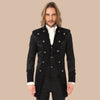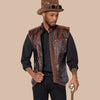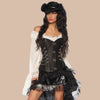Steampunk is a captivating blend of history, science fiction, and fantasy that transports us to an alternate version of the 19th century, where steam power reigns supreme, and technological advancements take on a fantastical twist. More than just a literary genre, steampunk has grown into a multifaceted cultural phenomenon encompassing fashion, art, music, and lifestyle. But what exactly is steampunk, and why has it captured the imagination of so many? Let’s dive into the world of gears, goggles, and grandeur.
Origins of Steampunk
The term "steampunk" was coined in the 1980s by author K.W. Jeter to describe a subgenre of speculative fiction that drew inspiration from the Victorian era and the works of writers like Jules Verne, H.G. Wells, and Mary Shelley. Unlike traditional science fiction, which often explores futuristic technology, steampunk imagines a world where steam power and clockwork mechanisms fuel innovation. This retro-futuristic aesthetic creates a unique juxtaposition of historical and imagined worlds.
Core Themes of Steampunk
At its heart, steampunk explores the intersection of human ingenuity and technology, often with an emphasis on adventure, exploration, and rebellion against societal norms. Key themes include:
- Industrial Revolution Aesthetics: Steampunk celebrates the beauty of machinery, from intricate clockwork gears to steam engines and airships.
- Victorian Elegance: The fashion, manners, and architecture of the 19th century provide a rich backdrop for steampunk stories and designs.
- Inventiveness: Steampunk heroes are often inventors, tinkerers, and explorers who use creativity to solve problems and push boundaries.
- Social Commentary: Many steampunk works critique industrialization, imperialism, and class inequality, offering alternative visions of progress and society.
Steampunk in Literature
Steampunk literature often features adventurous plots, richly detailed worlds, and larger-than-life characters. Notable examples include:
- "20,000 Leagues Under the Sea" by Jules Verne: A classic tale of exploration and technology.
- "The Difference Engine" by William Gibson and Bruce Sterling: A seminal steampunk novel imagining a world where mechanical computers revolutionize the 19th century.
- "Mortal Engines" by Philip Reeve: A dystopian series where mobile cities roam the earth, driven by steampunk technology.
Steampunk in Fashion
Steampunk fashion is an art form in itself, blending Victorian-era styles with industrial and fantastical elements. Common staples include:
- Clothing: Corsets, waistcoats, top hats, and military-inspired coats.
- Accessories: Goggles, pocket watches, and gear-adorned jewelry.
- Materials: Leather, brass, and lace create a tactile, layered aesthetic.
Steampunk in Art and Design
Artists and designers have embraced steampunk as a means of reimagining everyday objects and spaces. Steampunk art often incorporates repurposed materials and intricate craftsmanship to create:
- Sculptures: Mechanical animals, airships, and fantastical contraptions.
- Furniture: Pieces that blend Victorian elegance with industrial utility, like brass lamps or gear-adorned desks.
- Visual Media: Films like The League of Extraordinary Gentlemen and Wild Wild West bring steampunk visuals to life on screen.
Steampunk in Popular Culture
Steampunk’s influence extends far beyond books and art. It has become a thriving subculture with:
- Conventions and Events: Steampunk enthusiasts gather at events like the Steampunk World’s Fair to showcase their creations and celebrate the genre.
- Music: Bands like Abney Park incorporate steampunk themes into their lyrics and stage performances.
- Video Games: Titles like Bioshock Infinite and Dishonored immerse players in steampunk-inspired worlds.
Why Steampunk Resonates
Steampunk’s enduring appeal lies in its ability to inspire creativity and offer a fresh perspective on history and technology. It invites us to imagine a world where craftsmanship and artistry take center stage, blending the old and the new in endlessly inventive ways. The genre’s emphasis on individuality and innovation resonates with those who value self-expression and a sense of wonder.
How to Get Involved in Steampunk
If steampunk has sparked your curiosity, there are countless ways to dive into the genre:
- Read: Explore steampunk novels and short stories to immerse yourself in the worlds imagined by talented authors.
- Dress Up: Experiment with steampunk fashion by combining vintage clothing with mechanical-inspired accessories.
- Create: Build your own steampunk props, gadgets, or art pieces to bring your vision to life.
- Join the Community: Connect with other enthusiasts at local meetups, online forums, or conventions.
Final Thoughts
Steampunk is more than a genre; it’s a celebration of imagination, innovation, and the beauty of anachronism. By blending the elegance of the past with the possibilities of the future, steampunk invites us to reimagine the world and our place within it. Whether you’re drawn to its literary roots, artistic expression, or vibrant community, steampunk offers a creative escape that’s as timeless as it is inspiring.






















